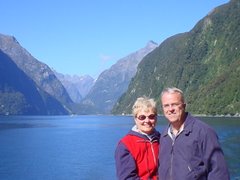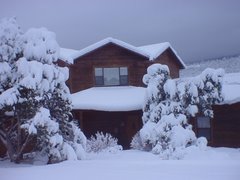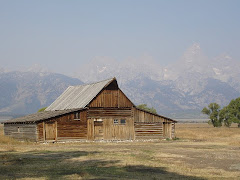Tuzigoot's manufacturer, Tiffin Motor Homes, has an owners club, called the Allegro Club because some of the company's models are named Allegro, like our Allegro Bus. NM has a chapter, the Zia Chapter. One of our members organized an extended weekend rally at the Tombstone Territory RV Park, located about 12 miles from Tombstone, AZ, interestingly enough, and where better to spend Halloween weekend than Tombstone -- Oooooo? Seven rigs, 14 people, came to Tombstone. Six of the rigs were Tiffins; one was an SOB (which we learned meant some other brand), but we're an inclusive group.
But first, I will note that on the way down we lost the cover to Tuzi's hot water heater. Either the latch wasn't secure (I don't recall messing with it, or checking it) or it worked loose on the way. The last time we made a trip to AZ, in Tuzi-one, we lost the hot water heater cover, too. Weird, huh -- Oooooo. Also, inspecting Tuzi's tires, during our overnight stay in Deming, NM, I found some sidewall cracks. Wasn't sure how worried to be about them. More on this later.
The Tucson Territories RV Park is a large park, well set-up for groups and large rigs. Had a nice kitchen and dining/club room that we used. Not too many people there at this time, but we understand it fills up for the winter season. It's fairly remote, 25-30 miles from the nearest grocery store, but has great panoramic views and a very friendly, helpful staff.
First day, 10/29, morning, we went to Kartchner Caverns State Park. This is a very new cave, in the sense that it was just discovered in 1974, purchased by AZ from the Kartchner family in 1988, and opened to the public only in 2003 after considerable construction and stringent design work aimed at preserving this active "wet" cave. For example, we went through four or five air-locks getting from the entrance to the cave itself. This maintains the natural atmosphere. Access is by a tram that takes you from the visitors center to the entrance. Also, nightly they hose down all the paved paths in the cave. There's no food, no picture-taking, no back- or fanny packs, no touching (the cave walls and formations) in the cave. The period from 1974 to '88 was one of secrecy and intrigue -- the discoverers above all wanted secrecy to prevent vandalism of the cave. The first time they took a State Parks official they blindfolded him, drove in circles a while, then to the cave after dark.
One neat thing is that the introductory video you see before entering the cave features the two discoverers. They explain and re-enact some of the discovery scenes. They had previously found a sinkhole partway up the side of a small mountain, thought it might lead to a cave (these guys know caves), but couldn't find an opening. On a later trip to look again, they found that the cave was exhaling -- the distinct odor of bat guano. They dug around, found an opening and eventually worked their way through a small tunnel -- in some places barely allowing head and shoulders through an opening -- some 400 feet into a room filled with formations like the ones in these pictures (copied and pasted from the website).


These are "soda straw" stalactites. The longest is about 20 feet long.

We've often found that the guides at historic and scenic landmarks really make the visits by their knowledge and enthusiasm. That was the case here: an octagenarian couple (I'd guess), he was the guide, she was the trailer, making sure no one transgressed or lagged behind, led and followed our group. He had lots of stories and theories about the chemistry underlying some of the formations. She carried a large flashlight that I suspected she would use on anyone who strayed. One piece of technical information from our guide: What's the difference between a cavern and a cave? A cavern has a gift shop.
One formation new to me was helactites. Couldn't find a picture, but these are small, ribbon-like, gravity-defying formations that grow horizontally and twist and turn in all directions. They look like petrified fungi of some sort. Water flow, mineral content, and air flow are believed to be the factors shaping these formations. Our guide thought that maybe microbes, one-cell living organisms, not just chemical reactions, might contribute to these formations.
(Note: When I say we went to the cave, that’s an editorial we. Susie doesn’t do underground confined spaces so she was one of our group that stayed in camp.)
After the cavern, the group then went to Sierra Vista for lunch and those who wanted to, including us, toured historic Fort Huachuca after lunch.
Fort Huachuca was one of a gaggle of forts strung across the SW in the late 1800s to protect settlers and travelers in the area and to fight the Indian wars. After Geronimo was captured and things settled down, many forts closed, but Huachuca remained active and it was from here that General Pershing led a “Punitive Expedition" into Mexico in pursuit of Pancho Villa, who had attacked Columbus, NM, in 1916 and killed 18 people. Various other missions such as intelligence and electronic warfare have kept Huachuca in business until this very day.
This statue, called The Eyes of the Army, celebrates the Indian scouts who guided the cavalry. You could say that intelligence and communication have been the Fort Huachuca missions for over a century.

Fort Huachuca sits above the desert floor on the flank of the Huachuca Mountains, which gives it a good view of the border country and its climate is not quite as hot as you might think. From various soldier quotes that we read in the Fort’s museum, though, it was not a particularly beloved spot. Mostly, though, they complained about having to do common labor building and maintaining the fort, rather than real soldier duty. Various luminaries served there including Patton and the father of Fiorello LaGuardia, who was the fort’s bandmaster.

The museum has some interesting exhibits and a good video thoroughly describing fort history. The famed Buffalo Soldiers served here in several capacities, as is well-represented at the museum.

A busy, interesting day. Here's a campground sunset.
Next, Day 2.
Cheers,
Rob and Susie






















